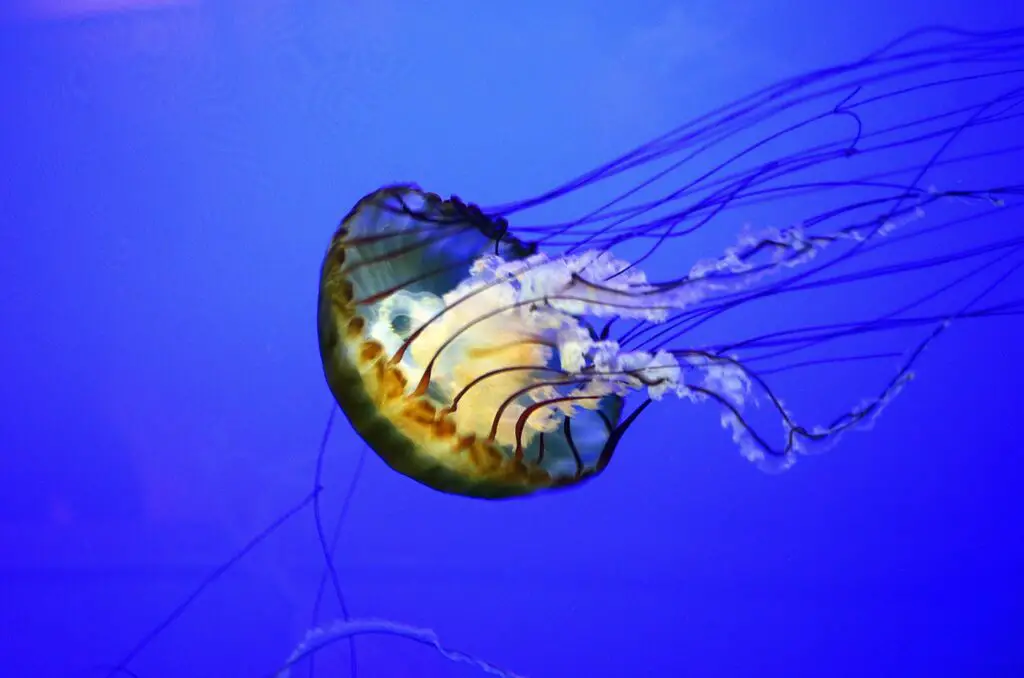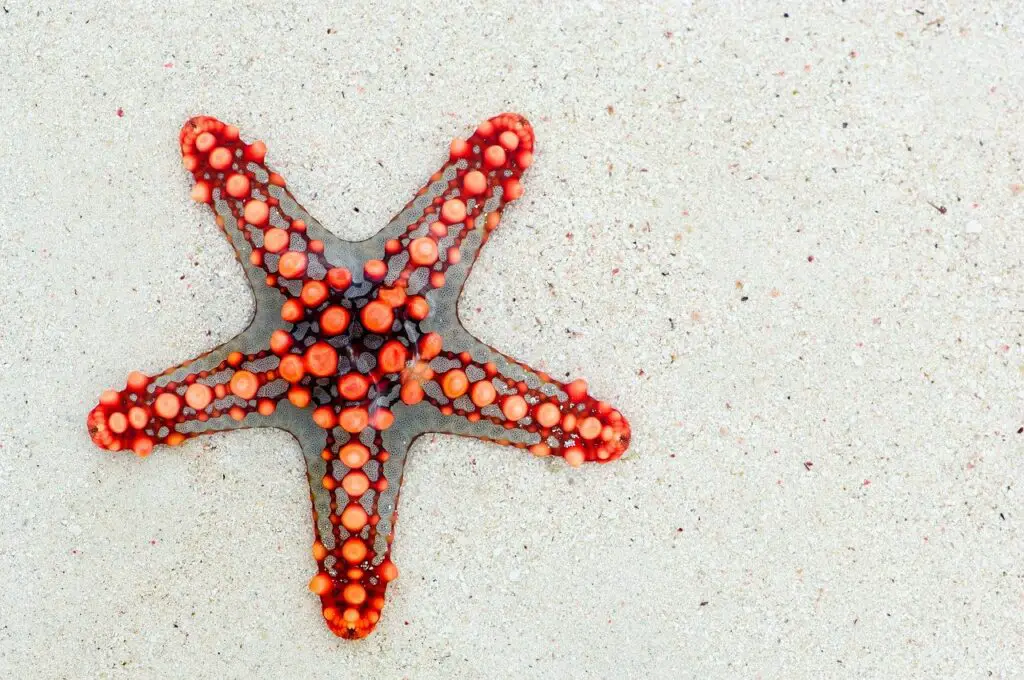Are Jellyfish and Starfish similar to Fishes?
Well! It’s a very often asked query. Are Jellyfish and Starfish similar to Fishes?
Jellyfish and Starfish have one thing in common is the word ‘fish’ attached to their name. They are not true fishes.
Jellyfish and Starfish are not true fishes because they don’t have gills, fins, scales, and a vertebra. Strictly in Zoology, a fish is usually a true fish or fin fish that distinguishes them from other aquatic species.
And so, Jellyfish and Starfish are not similar to Fishes.
Yes, it’s true that both the Jellyfish and Starfish are aquatic. This doesn’t mean that all aquatic animals need to be fishes or true fishes.
A true fish has gills, fins, scales, and a vertebra. These body parts Jellyfish and Starfish lack.
In fact, Jellyfish, Starfish, and any other true fishes are three separate types of organisms that cannot be treated equally. These are widely different and distinct from each other.
They are marine animals, meaning they live in the saltwater of the ocean. They both share a few similarities but in neither way similar to fishes.
So, if you still think that both Jellyfish and Starfish are similar to fishes, then there’s a big answer to it. It’s, “NO! NO! NO! Jellyfish and Starfish are not fishes. They are a lot different from fishes.“

Reasons why Jellyfish and Starfish are not similar to Fishes:
1. Jellyfish falls under Phylum Coelenterata, Starfish falls under Phylum Echinodermata, while fishes fall under Phylum Chordata.
2. Jellyfishes are Radially symmetrical, Starfishes are Radially symmetrical, but Fishes are Bilaterally symmetrical.
3. Fishes have gills, fins, scales, and a vertebral column, Jellyfish and Starfish don’t.
4. Jellyfishes are lower invertebrates, Starfishes are higher invertebrates, while Fishes are lower vertebrates.
5. Jellyfishes have tissue level of body organization, Starfishes have very simple organ system level of body organization, fishes have a complex organ system level of body organization.
6. Jellyfish don’t have a skeleton, a brain, or a central nervous system. Starfish have no brain, have a skeleton made of calcium carbonate plates known as ossicles forming granules or spines, and have a complex nervous system but not a central nervous system. Fishes have a skeleton, a brain, or a central nervous system.
7. Jellyfishes and Starfishes have no blood in their body whereas, fishes have blood and they are cold-blooded.
8. Body of Jellyfish looks like a ball of gelatin (jelly-like) with tentacles that hang down underneath them, kind of like of an Octopus. Body of Starfish looks like a central disc having five to a larger number of arms with smooth, granular, or spiny upper surface that may be covered with overlapping plates. The body of a fish is divided into a head, trunk, and tail.
9. The jellyfish only have a very thin layer of covering so that oxygen and nutrients can be easily absorbed and spread through their bodies. Starfishes have seawater (instead of blood) which is actually used to pump nutrients through their bodies via. a water vascular system. In fishes, they have the simplest circulatory systems of the vertebrates where blood flows unidirectionally from the two-chambered heart through the gills and then to the rest of the body.
10. Jellyfish use muscles to propel themselves and use a small portion of tentacles to give the direction of movement. Starfish use their hundreds of tube feet placed underside for walking around, for attaching tightly to the rocks, or for holding on to the prey. Fishes move by flexing their bodies, fins, and tail back and forth.
11. Jellyfish eat and discard from the same mouth opening. Starfish feeds by extending its stomach out of its mouth over the digestible parts of its prey and excrete through its tube feet. Fishes, on the other hand, eat through their mouth and excrete through the gills as ammonia.
12. Jellyfish reproduces both sexually and asexually which involves several different stages one after another. Starfish reproduces sexually in the winter and asexually at other times of the year. Nearly all fishes reproduce sexually, and most species have separate sexes.
Read the characters of Jellyfish, Starfish, and Fish to understand each one properly:

Characters of Jellyfish
1. Jellyfishes are aquatic animals that belong to the Class Scyphozoa of Phylum Coelenterata.
2. Their upper body is transparent and umbrella-shaped that has tentacles with stinging cells which they use to capture their prey and as a form of defense.
3. The tentacles of a Jellyfish with stinging cells contain capsules that can inject poisons to kill its prey.
4. Their tentacles push them forward and are always with the speed of the water currents of the sea. Water current moves them, as they rarely move of their own.
5. Their body is gelatin type (jelly-like) and transparent which is composed of 95% water and so they can perfectly camouflage inside water.
6. The body of a jellyfish exhibits radial symmetry and is divided into three main parts: the umbrella, the oral arms (around the mouth), and the stinging tentacles.
7. They have an internal cavity, in which digestion is carried out. This cavity has a single aperture which functions both the mouth and the anus.
8. Jellyfish are carnivores and can increase their size rapidly when food is abundant. they become small during the scarcity of food.
9. Their stages of development and reproduction include both sexual and asexual types.
10. They mainly feed on phytoplankton, zooplankton, small crustaceans, very small fishes, and even other jellyfishes.

Characters of Starfish
1. Starfishes are aquatic animals that belong to the Class Asteroidea of Phylum Echinodermata.
2. These are marine higher invertebrates that display pentamerous radial symmetry of the body and an exoskeleton of calcareous plates and spines. Their larval stage is bilaterally symmetrical.
3. They are free-living and occur on sandy or muddy buttons of the sea or crawl about over rocks or shells of other molluscs. They move very slowly and adhere tightly to their resting place with the help of their tube feet.
4. They are carnivores in nature. They mainly feed on phytoplankton and zooplankton trapped in mucus secreted by their body and carried to their mouth by cilia.
5. As soon as the starfish comes out of the egg, it enters its various larval stages of development. So, it can be well said that the starfish is born in the form of larvae starting their marine life. Many starfish species are known to remain in their larval stage until they are four to five years old. They then show metamorphosis and enter their adult stage, with having a life expectancy of about ten to thirty years age.
6. Starfishes have seawater (instead of blood) which is actually used to pump nutrients through their bodies via. a water vascular system.
7. Starfish feeds by extending its stomach out of its mouth over the digestible parts of its prey and excrete through its tube feet.
8. They don’t have eyes, brain, or any central nervous system. They do have is a skeleton made of calcium carbonate plates and a complex nervous system with one sensory tentacle at the end of each arm.
9. Body of Starfish looks like a central disc usually having 5 arms commonly, with some specimens have 20 arms as well. Their body has spiny upper surface that may be covered with overlapping plates.
10. They are the quietest and calmest aquatic animal known. They usually carry out all their activities at night. During the day they tend to be inactive, as a strategy to avoid their predators.

Characters of Fishes
1. All the fishes are included in Phylum Chordata, Subphylum Vertebrata, and in Superclass Pisces.
2. Fishes are all fish-like aquatic forms with paired as well as median fins, gills, and scaly skin.
3. They are all aquatic, herbivorous or carnivorous, cold-blooded, oviparous or ovoviviparous vertebrates.
4. Their body is usually streamlined, spindle-shaped, some are elongated snake-like and a very few are dorsoventrally compressed. Their bodies can be well differentiated into head, trunk, and tail.
5. Locomotion is usually done by paired pectoral and pelvic fins along with median dorsal and caudal fins, supported by the true dermal fin rays. Muscular tail is used in propulsion.
6. Fishes have a two-chambered heart, meaning that amongst all of the vertebrates they have the simplest circulatory system. The blood In a fish’s heart flows unidirectionally i.e. the blood flows from the heart through the gills and then it flows to the rest of the body.
7. Both sexes, male and female are different. The Gonads (testis and ovary) are typically paired. Gonoducts open into cloaca or independently.
8. The body is covered by scales. They are placoid scales, cycloid scales, ctenoid scales, ganoid scales, etc.
9. Respiration is by gills. Gills are the extensions of the pharynx. In the elasmobranches fishes, the gills will open separate. In bony fishes the gill slits are covered by operculum.
10. The body shows paired and unpaired fins. Pelvic and pectoral fins are paired. Dorsal and ventral fins are unpaired. They maintain balance in the water. They are useful for locomotion.
CONCLUSION
Jellyfish and Starfish are not true fishes. In fact, these three organisms are different from each other and have very few similarities in common.
People often get confused with their names, as the word ‘fish’ is included both in Jellyfish and Starfish.
These types of names were given to them when the present-day classification system was not present. It’s because people during the early days considered all aquatic animals like fishes.
But biologically if you see, these are not true fishes. And, it can be seen that these 3 living animals are widely different and distinct from each other.
